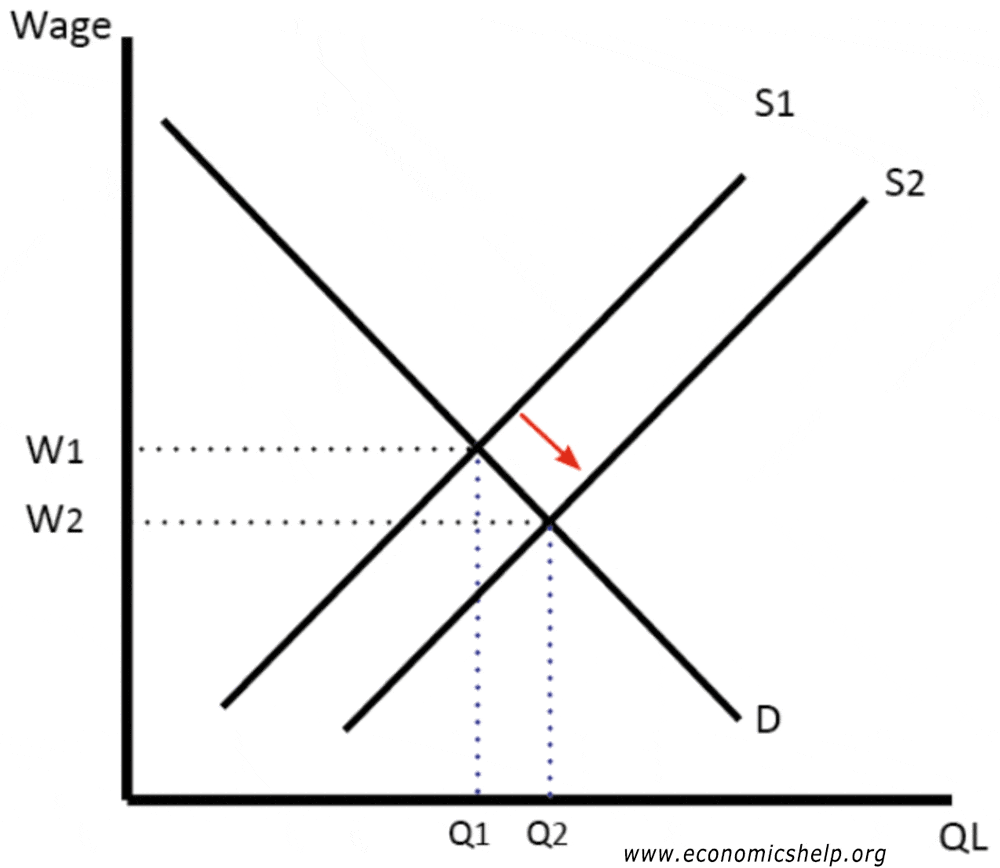A look at factors that determine an individuals supply of labour and the market supply of labour.
- Higher wages usually will encourage a worker to supply more labour because work is more attractive compared to leisure.
- Therefore the supply curve for labour tends to be upwardly sloping.
- However, a worker isn’t just interested in earning money; they are also interested in leisure. Therefore, there is a choice between working more (higher wage) and working less (more leisure).
Two factors that influence a workers supply of labour
1. Substitution effect of a rise in wages
With higher wages, workers will give greater value to working than leisure. With work more profitable, there is a higher opportunity cost of not working. The substitution effect causes more hours to be worked as wages rise.
2. Income effect of a rise in wages
This occurs when an increase in wages causes workers to work fewer hours. This is because workers can get a higher income by working fewer hours. Therefore they may work less.
Therefore, after wage rise, workers may work less because they can get their target income with fewer hours spent working.
Backward sloping supply of labour

- After W2, the income effect outweighs the substitution effect. Now people work fewer hours because they can get their target income from a lower number of hours.
Market Supply of Labour
Market supply of labour for a particular vocation depends upon:
1. The number of qualified people
For example, the number of qualified accountants is low, therefore supply is quite inelastic. For a job such as fast-food operator, the number of potentially qualified people is a high percentage of the labour force, therefore supply is much more elastic
2. Difficulty of getting qualifications
If it is difficult to get particular qualifications, supply will be inelastic. For example, even if wages of economics teachers rose, the supply would be quite inelastic – to become qualified would take several years.
3. The non-wage benefits of a job
Unpleasant jobs will have fewer people willing to do them therefore supply will be relatively lower. Although many unpleasant jobs, such as cleaning are relatively low-skilled so may still be low paid.
4. The wages and conditions of other jobs
If many jobs in a local area are considered unpleasant – e.g. fruit pickers, then the supply of alternatives will be relatively higher.
5. Demographic changes and immigration
Some jobs, such as fruit picking are unpopular with native-born workers and rely on immigrant labour. If immigration slows down, there can be vacancies in these particular jobs. Post-Brexit vote, farmers reported difficulty in filling labour vacancies due to a slowdown in immigration.
Impact of increase in the supply of labour

An increase in the supply of labour leads to a fall in the wage rate from W1 to W1. Quantity increases from Q1 to Q2.
Effect of increase in supply and demand for labour
If immigration led to an increase in the supply of labour (more workers) then wages would initially fall. However, net migration would also lead to increase in demand for labour because the new workers create additional demand in the economy.
Supply of labour in perfect competition
In a perfectly competitive labour market, wages are determined by supply and demand (We). For an individual firm, the supply of labour is perfectly elastic. They are wage takers and employ workers at the market wage of We.
Wages and elasticity of supply
If supply is more inelastic, this tends to lead to higher wages. (Supply 1) leads to W2
Lump of labour fallacy
The lump of labour fallacy is the contention that the amount of work available in an economy is fixed. But, most economists argue this belief there is a fixed number of jobs (or a fixed number of hours) is usually incorrect.
Immigration increases labour supply – so we may expect a fall in wages.
However, this is only half the story. Net migration increases demand in the economy, causing an equivalent rise in demand for labour. The net effect should be – wages stay constant. (Though we can see differing impacts in certain labour markets – depending on skill levels of migrants)
Related posts on labour supply
- Impact of immigration on UK economy
- Reasons for net migration into the UK
- Immigration and the black market
- Flexible labour markets and immigration
- Demand for labour




